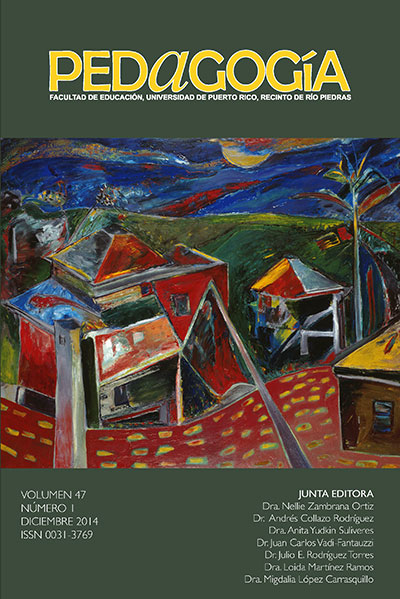Abstract
The purpose of this research was to explore possible differences between public and private school students with respect to: scores on standardized aptitude and achievement tests used as admission criteria to higher education institutions in Puerto Rico, the set of college success predictors, and the relative predictive value of each predictor, individually and in combination with other predictors. Major study findings were: private school students‘ aptitude and achievement tests scores were higher than those of public school students; correlation coefficients between selected predictors and criteria, freshman‘s GPA and graduation‘s GPA, were higher for private school students, and the set of college success predictors for both school types were similar. Possible explanations for the differences in academic performance are considered.
How to cite:
Colorado-Laguna, R. J., & Corcino-Marrero, L. (2014). Diferencias en el desempeño académico y en los predictores de éxito universitario por escuela de procedencia. Pedagogía, 47(1), 159-191. Retrieved from https://revistas.upr.edu/index.php/educacion/article/view/16364
References
American Educational Research Association [AERA], American Psychological Association [APA] & National Council of Measurement in Education [NCME]. (1999). Standards for educational and psychological testing. Washington, DC: AERA. Recuperado de https://law.resource.org/pub/us/cfr/ibr/001/aera.standards.1999.pdf
Borg, R. B. & Gall, M. D. (1983). Educational research: An introduction (4ta. ed.). New York: Longman.
Bridgeman, W., McCamley-Jenkins, L. & Ervin, N. (2000). Prediction of freshman grade point average from the revised and recentered SAT I: Reasoning Test. College Board Research Report No. 2000-1. New York: College Entrance Examination Board. Recuperado de http://research.collegeboard.org/sites/default/files/publications/2012/7/researchreport-2000-1-predictions-freshman-gpa-revised-recentered-sat-reasoning.pdf
Burton, N. W. & Ramist, L. (2001). Predicting success in college: SAT studies of classes graduating since 1980. College Board Research Report No. 2001-2. New York: College Entrance Examination Board. Recuperado de http://research.collegeboard.org/sites/default/files/publications/2012/7/researchreport-2001-2-predicting-college-success-sat-studies.pdf
Center for Educational Policy [CEP]. (2007). Are private high schools better academically than public high schools? Washington, D.C.: Autor. Recuperado de: www.edline.com/uploads/pdf/PrivateSchoolsReport.pdf
College Board [CB]. (s.f.). Programa de Evaluación y Admisión Universitaria (PEAU). Recuperado de http://oprla.collegeboard.com/ptorico/pr/program/peau.html
Colorado, R. & Corcino, L. (2013). Validez de predicción de los criterios de admisión a la Universidad de Puerto Rico. Revista Pedagogía, 46(1), 66-92.
Geiser, S. & Santelices, M. (2007). Validity of high-school grades in predicting student success beyond freshman year: High-school record vs. standardized tests as indicators of fourth-year college outcomes. Research & Occasional Paper Series: CSHE.6.07. Recuperado de http://cshe.berkeley.edu/publications/docs/ROPS.GEISER._SAT_6.12.07.pdf
Geiser, S. & R. Studley. (2002). UC and the SAT: Predictive validity and differential impact of the SAT I and SAT II at the University of California. Educational Assessment, 8(1), 1-26.
Hawkins, D.A. & Clinedinst, M. (2006). State of College Admission. Alexandria: Virginia: National Association for College Admission Counseling. Recuperado de http://www.immagic.com/eLibrary/ARCHIVES/GENERAL/NACAC_US/N060508H.pdf
Hinkle, D., Wiersma, W. & Jurs, S. (1994). Applied statistics for the behavioral sciences (3ra. ed.). Boston, Mass.: Houghton Mifflin Company.
Menéndez, A. (1995). Estudio sobre el proceso de admisiones a la Universidad de Puerto Rico. Informe presentado a la Administración Central de la
Universidad de Puerto Rico.
Menéndez, A. (1996). The predictive validity of admissions measures at the University of Puerto Rico (Disertación doctoral). Rutgers University.
Messick, S. (1994). The interplay of evidence and consequences in the validation of performance assessments. Educational Researcher, 23(2), 13-23.
Punch, K. F. (2004). Introduction to social research: Quantitative and qualitative approaches. Londres: Sage Publications.
Ramist, L., Lewis, C. & McCamley-Jenkins, L. (1993). Student group differences in predicting college grades: Sex, language and ethnic groups. College Board Research Report No. 93-1. New York: College Entrance Examination Board. Recuperado de http://research.collegeboard.org/sites/default/files/publications/2012/7/researchreport-1993-1-studentgroup-differences-predicting-college-grades.pdf
Zwick, R. (2007). College Admissions Testing. Report for the National Association for College Admission Counseling (NACAC). Recuperado de http://www.nacacnet.org/research/PublicationsResources/Marketplace/Documents/TestingWhitePaper.pdf
The contents published in the Puerto Rico Journal of Education is freely distributed under open access practices, in accordance with the Creative Commons license, Attribution-NonCommercial 4.0 International (CC BY-NC 4.0). Through these principles, the journal and its authors allow readers to access, reproduce and share articles in full text. Users should give credit to authors in a reasonable way without suggesting they have their support. Under no circumstances, readers may make use of the contents for commercial purposes. The authors retain copyright on their works.

